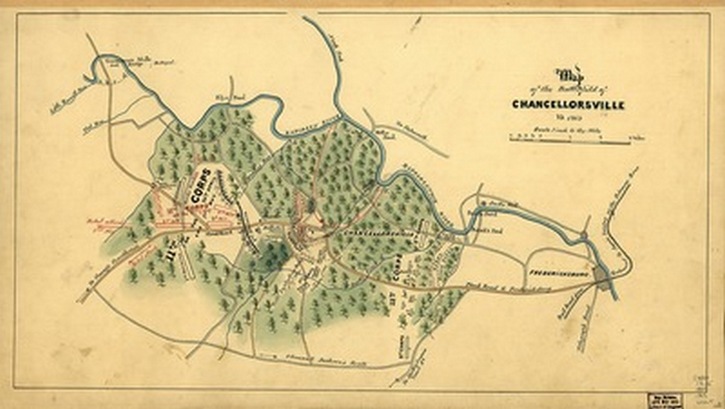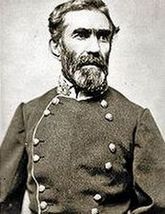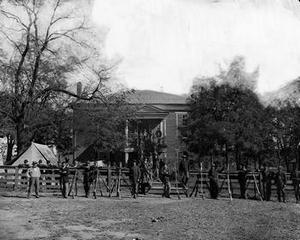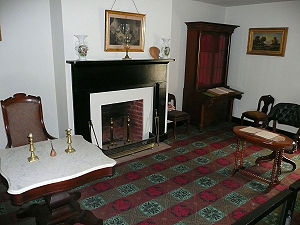Battles of the Civil War
Contents
1803-1860
Signals of Impending War
Triumvirate
Political Currents
Insurrection
Lincoln
Chapter 2
1863 Battles
1864 Battles
1865 Battles
Civil War Facts
Consequences of the War
Death
Destruction
Union
In 1861 and 1862, Congress had passed several measures aimed at freeing slaves from bondage.
In September 1862, Lincoln had issued a
warning to southern states setting a January 1, 1863 deadline as the
time for all states in rebellion to return to the Union. Public
opinion in the north was solidly behind these efforts. Union generals
were promoting their own pro abolitionist views in their handling of slaves
that came into their camps. Lincoln, during these years,despite his
repugnance for slavery, had avoided connecting slavery with the hope that would bring an early peace and preserve the Union.
1863
January 1: President Abraham Lincoln chose New Year's day to officially, by executive order, interject the slavery question into the war. His Emancipation Proclamation was aimed squarely at white, southern slave owners and rebellious states. All slaves in those territories were freed.
"all persons held as slaves within any State or designated part of a State, the people whereof shall then be in rebellion against the United States, shall be then, thenceforward, and forever free."
Counter Point: Response by President Jefferson Davis of the Confederacy :
"Emancipation Proclamation is a worthless act".
September 24: Rebuttal: Lincoln suspended the Writ of Habeus Corpus aimed at detention of southern sympathizers living in the north, and subjecting them to military justice and effectively depriving them of a civilian right. (Later declared unconstitutional by Supreme court although enacted into law by Congress.)
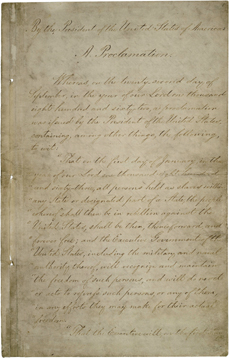 |
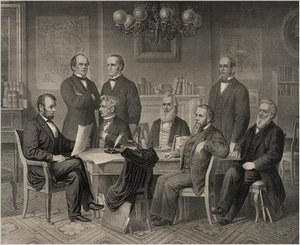 Library of Congress- Stonesong Press National Archives Battles of the Civil War |
Southern civilians were now feeling the privations of war. Hoarding goods became common and sold to the public at inflated prices. The Confederate government exacted a tax on personal possessions. Nothing was exempt except slaves. Farmers had to contribute one tenth of their crops to the army, and any purchases made for the army was exchanged for increasingly worthless script. There was evidence of trading with the enemy. Cotton was getting through to the north for "Yankee" gold.
Few blockade runners were able to slip through the coastal cordon set up by the Federal navy. Those that did were lauded. They returned with manufactured goods, and much needed rifles. Family urine was saved for its saltpeter used in the manufacture of gun powder.
Slaves were escaping en masse.The treatment for those still held in bondage was increasingly harsh.
This was the economic background in 1863 as the war continued unabated.
Chancellorsville
2nd Battle of Fredericksburg
Eastern Theater Campaign Continues
Wrapped around the January 1, 1863 date were the battles at Stone River, Tennessee (December 31-January 1,) and Galveston,Texas (January 1). The former was a questionable Union victory, but the latter resulted in the expulsion of Union forces from Galveston. The most significant change was replacing General Burnside with General Joseph Hooker in command of the Army of the Potomac. Hooker has been described by the National Park Service in an essay on Chancellorsville as "endowed with high courage and low morals".
The initial 4 months of 1863 featured several battles without serious consequence. As April ended, this changed at Chancellorsville, Virginia, as the Hooker plan was ready for implementation. Richmond was the ultimate target which would separate the Confederate capital from Lee's army. Victory in this part of Virginia would open the southern road to Richmond
Fredericksburg was still part of the Union battle plan to be executed in the spring of 1863. (see Chapter 1 for first battle- Dec. 1862.)
General Sedgwick was ordered to cross the Rappahannock River as a deception to engage Lee's 60,000 troops south of Fredericksburg, Virginia. With General Sedgwick in the east, Hooker would take his force 10 miles west, cross the same wide river, and attack Lee's encampment from the rear. Hooker would have an army twice the size of Lee's.
April 30-May 6: The Sedgwick feint at Fredericksburg did not fool Lee. He courageously pulled forces from that area to shore up his other forces. On May 1, Hooker moved south toward the rebel lines and was forced to traverse a heavily wooded area which was known as the Wilderness. His forces came under heavy rebel fire and Hooker pulled back to escape the woods. A mistake he would regret leaving that ground to the rebels.
On the
following day, Hooker ignored intelligence of a build up of rebels to
the west. That afternoon the Union forces were attacked by
General Jackson's troops and forced back several miles to the temporary
respite of darkness. During that night, Jackson accompanied by
several staff officers rode out between the lines to plan a night
attack. He and two of his men were struck by bullets from a jumpy
Confederate line. Jackson's left arm required amputation. Several days
later he died of pneumonia. Lee said that Jackson had lost his left arm,
and he, Lee,,had lost his right arm. J.E.B. Stuart assumed temporary
leadership of Confederate forces and led them to victory.
There was a temporary victory when the blue coats gained the heights above Fredericksburg. The following day the gray coats had recovered the position for the rebels.
Hooker was a beaten man. He had lost 16,000 men (Confederates 13,000) and recrossed the wide Rappahannock.
New York World editorial: "Union Army led by incompetent general" (Hooker).
The grief Lincoln felt upon receipt of the news is understandable. How many more losses could the Union sustain?
Battles of the Civil War
click to enlarge
Battles of the Civil War
Vicksburg Campaign
Western Theater
Champion Hill
May 16: Champion Hill lies 20 miles east of Vicksburg, Mississippi. Confederate forces led by Lt.Gen. John Pemberton held the important Crossroads and heights. A surprise move by General Grant brought his forces to the rear and flank of the rebels. Under heavy bombardment, the Union assault dislodged the southern troops. Pemberton counterattacked, but a new attack and the blue clad soldiers forced Pemberton forces to retire. The route to Vicksburg was open where Pemberton would have another chance.
From April 29 to May 16, Grant achieved a series of objectives including capturing of Jackson, Mississippi, the state capital (May 14). None were decisive as the battle that followed.
Battles of the Civil War
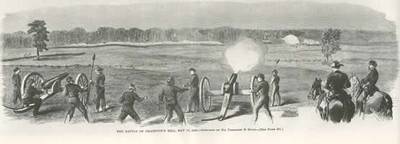
Champion Hill
Harper's Weekly
Siege of Vicksburg
May 18-July 4: The city of Vicksburg was heavily fortified with batteries that controlled this southern portion of the Mississippi River. Grant's plan included an assault with Union gunboats and a land approach led by Grant. The gunboats also met resistance from Confederate ships as well as mines laid by the rebel forces. However, the iron clad Union ships proved superior.
However, as the USS Cairo made its way down the Mississippi, it was struck by the first electric torpedo and sunk immediately. All hands were saved.
Battles of the Civil War
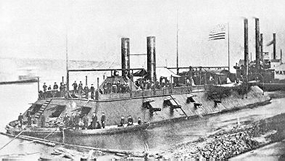
Battles of the Civil War
After a series of maneuvers, Grant's Army of Tennessee made contact with his gunboat flotilla. This began a siege of the city and 6 weeks of hunger besetting its defenders and citizens. The series of Union victories had cut Vicksburg's supply routes. Pemberton, who repelled two direct attacks, was forced to surrender the city one day after the Confederate's forced retreat at Gettysburg. To add to the woe of the Vicksburg defeat, there was the loss in Mississippi ending with the siege of Port Hudson (May 21-July 9).
Pemberton's reputation unfairly suffered. Reinforcement and supplies were not forthcoming based on the questionable decision of the general staff who were within marching distance to render relief.
Battles of the Civil War
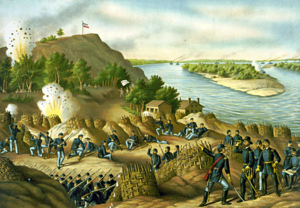
Library of Congress
June 13-15: General Lee was formulating plans for his invasion of Pennsylvania. He required clearing the Shenandoah Valley which ran like a north/south spine through central Virginia, and strategically located near the Pennsylvania border. He first required the destruction of Union forces in the valley that could attempt to interdict his armies moving northward.
Winchester, now occupied by Union soldiers, was a thorn that had to be removed. It's location, less than 80 miles south west of the Pennsylvania border, was an impediment. Winchester was occupied by the Union's Second Corps. This force, a portion of the Federal's Middle Department, were about to face the entire rebel corps of the Army of Northern Virginia.
Confederate Lt.Gen. Richard Ewell ordered flank attacks on the strong fortifications that initially resisted. The 7,000 Union force commander, Maj. Gen. Robert Milroy, still did not realize he was facing 19,000 Confederate soldiers. His men were about to be overrun and barely escaped to join other Federal lines. They left behind 4,000 prisoners. Casualties, measured against other major battles, were moderate.
Battles of the Civil War
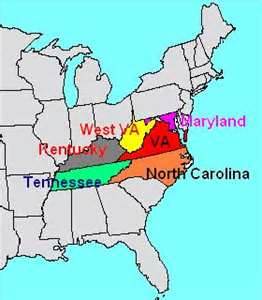 |
Battles of the Civil War
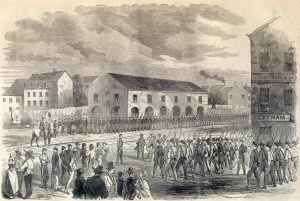 Confederate Soldiers in Winchester Penn.Virginia Border
Battles of the Civil War
|
Eastern Theater
Lee Invades the North
July 1-3: General Lee had always had his sights on an invasion of the north, and more particularly Pennsylvania. His campaigns in Maryland and victory at Chancellorsville was the road he traveled for his move north.
Gettysburg lies in Pennsylvania immediately north of the Maryland border. Lee, wasted no time, when he was in striking distance. He attacked the hastily prepared defenses set by General Gordon Meade just three days into his command of the Army of the Potomac. He had replaced Joseph Hooker. Lincoln was still looking for the capable man to lead the Union armies.
Day 1 at Gettysburg ended with retreating Union forces rushing through the town's streets and digging in on the hills south of town.
Day 2 at Gettysburg began in the afternoon with attacks on the Union's left and right flanks. The "Yankees" put up fierce resistance at Culp's Hill, Little Round Top and the Devil's Den. The defenses held at all locations
Battles of the Civil War
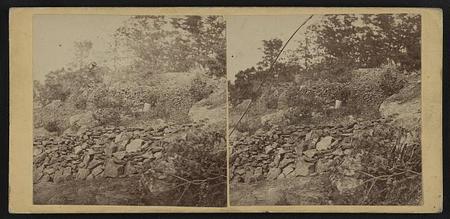
Breastworks at Round Top
Library of Congress
Day 3 at Gettysburg was an attack on the Union center appropriately named "Cemetery Hill". Picketts charge was deadly for the 12,500 grey uniformed men. They were exposed and raked on a 900 yard long open field that subjected them to artillery and rifle fire from the Union's higher vantage point. Some of the rebels reached the stonewall that offered the Union soldiers cover. They were repulsed. The frightening loss of life on that field was pre-ordained by the tactical decision that chose the location for the attack and the advantage of Union positions.
The three day battle left a total casualty count of 50,000 men. Lee was forced to retreat to Virginia. His forces would, thereafter, only be a defensive threat. Any possibility of a compromise peace was destroyed.
Four months later Washington notables attended a memorial service on the battlefield. President Lincoln delivered his famous address which also redefined the nature of the war.
Below: Battle Map of Picketts Charge, Union General George Meade and Cyclorama rendering of the attack.
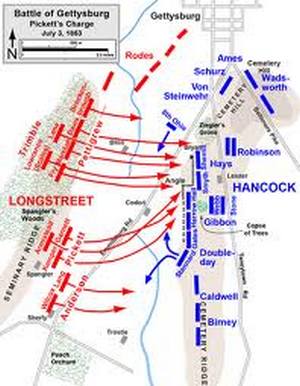 |
Battles of the Civil War
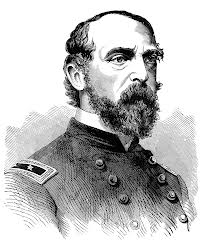 |
Battles of the Civil War
Battles of the Civil War
Battles of the Civil War
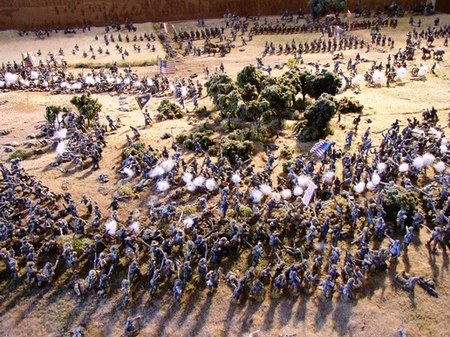
Battles of the Civil War
Chickamauga, Tennessee and Georgia
Western Theater
September 19-20: Earlier in the month, General Braxton
Bragg had been forced from Chattanooga by northern Gen. William Rosecrans Army
of the Cumberland. His Army of Tennessee was now ready to confront
Rosecrans at Chickamauga. Heavy fighting ensued. Rosecrans committed a
tactical error that created a gap in his line which was exploited by
the Confederates led by Lt. Gen. Longstreet. The Union forces recovered,
but fought a defensive battle until they retreated marching back to
Chattanooga. Casualties were about even, but extraordinarily high at
34,000 men. Battles had extended into northwestGeorgia. General officers were expected to lead in battle and often targeted. They were not immune from appearing on the casualty lists. Confederate Major General John Bell Hood was fortunate to survive an amputation of his right leg. A preponderance of amputations resulted in death. Two months earlier, at Gettysburg, he was struck by shrapnel in the left arm. In 1857, in the service of the Union Army, Hood was struck by a Comanche arrow in his hand.
Chattanooga, Tennessee
November 23-25: General Bragg had no intention of leaving
Rosecrans in possession of Chattanooga. The city possessed an important
railroad crossing that connected the eastern and western parts of the
Confederacy. Bragg began siege of the city with his Army of Tennessee on the heights over looking the Union forces. The Federals were facing a determined officer displayed below.
General Grant was now commander of all Union forces in the Western Theater. He immediately filtered in reinforcements from the Eastern Theater under General Hooker who had recently been victorious at the Battle of Lookout Mountain on November 24. Additionally, the western forces of General William T. Sherman was added to the mix.
Grant ordered attacks on the right flank and the center of the Confederate line. Sherman's corps was unable to breach Bragg's lines. The Union Maj. Gen. George H. Thomas had distinguished himself in fighting a rear guard action that protected Rosecrans troops as they retreated from Chicamauga. He now assaulted Bragg's army entrenched on Missionary Ridge and routed them. Bragg hurriedly retreated leaving the field to Grant and ended rebel control of Tennessee, but not ending the small, inconclusive skirmishes that followed through 1864. It would be a year before another major battle was fought in Tennessee. It was not enough to deter General Sherman a clear path to Atlanta, Georgia.
Battles of the Civil War |
|
Battles of the Civil War
Battles of the Civil War
1864
February 20: Operating out of the Union's Department of the South, one of 16 departments of the army, Maj.Gen.Truman Seymour was ordered to interdict the Confederacy's Floridian supply lines. He loaded 5500 men on board of coastal vessels destined for Jacksonville, Florida. This area had been secured by northern forces in 1862. Once landed, he conducted small raids on Confederate camps. Seymour may have exceeded orders by moving his troops inland.
Gen. Seymour marched his forces southward into north central Florida where he was met by a well prepared Confederate force at Olustee, near the current Lake City area. He was repulsed by heavy fire and forced to retreat toward the safety of Jacksonville. His rear guard of black Union soldiers successfully fought off the Confederate pursuit.
Union casualties were extremely high and numbered almost 2,000 including the missing.It is alleged that many black soldiers that were captured were murdered by their captors.
March 9: Grant was promoted to Lt. Gen. and Commander of all Union forces.
March and April involved small and inconsequential skirmishes at Fort De Russy and Mansfield, Louisiana.
Changes in Union Army's Top Military Command
October 31: 1861 Winfield Scott, the "old soldier", was relieved from duty as Supreme Commander of the United States Army.
November 1, 1861; George McClellan was promoted to General-in-Chief.
March 11, 1862: President Lincoln relieved George McClellan as General-in-Chief of the U. S. Army. He continued as Commander of the Army of the Potomac.
July 11, 1862: President Lincoln named Henry Halleck, General-in-Chief.
March 9, 1864: Ulysses S. Grant was promoted to Lieutenant General and given command of all active United States forces.
March 12, 1864: An insulted General Henry Halleck was relieved of duty at his own request.
General Grant Battles of the Civil War
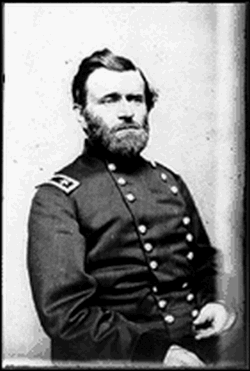
Battles of the Civil War
The Blue and Gray: Virginia on Their Minds
Wilderness
May 5-7: General Grant formed a new expeditionary force (Overland Campaign) to capture Richmond, Virginia State Capital. Six prior thrusts had been repulsed beginning with Bull Run in 1861. The Grant strategy was to organize all Union forces to perform in concert rather than independently of each other. Thereby constantly exerting pressure on Confederate armies wherever they were staged in the east; potentially enveloping the rebel armies by coordinated strategies.
General George Gordon Meade would lead the Army of the Potomac aimed directly at Lee's headquarters north of Fredericksburg. Three other army corps would attack Confederate forces from the James River, another in the Shenandoah Valley. General Sherman was ordered to leave Chattanooga, and the west, and strike at Atlanta.
Grant made his headquarters with Meade's forces and desired to directly confront General Lee. The army encamped the night of May 4 on fields holding the uncovered bodily remains on the Chancellorsville battle ground of the prior year. Beginning late the next morning, many on both sides would fall and join the their lately departed comrades. The battle raged for 2 days in a dense forest that made lines impossible to form, and equally difficult to distinguish friend and foe. Many fell struck by friendly fire.
On the second day, Grant was able to break a wedge in to the center of the gray line. Lee, at the head of his forces, made an impassioned plea to his Texas forces.They counter attacked opening a gap for General John B. Gordon to turn Grant's right flank. The Federal army had been repulsed. A chastened Grant, however, did not pause or retreat as was the custom of prior Union commanders who would turn tail after a defeat. Grant's message to President Lincoln:
"Whatever happens we will not retreat."
May 8-21: Gens. Grant/Meade were immediately on the move after the prior battle, ignoring the casualties of both sides the loss of almost 30,000 men. However, one effect would have long term consequences --- bleeding the diminishing forces of the Confederate armies. Both armies now raced to Spotsylavania County. Lee was a step ahead and his forces dug in awaiting a Union attack. Two weeks later, and over 30,000 casualties, the net result, was at best, a draw, and only significant to the burial details. Nevertheless, Grant's pressure was inexorably pushing Lee southward.
Battles of the Civil War
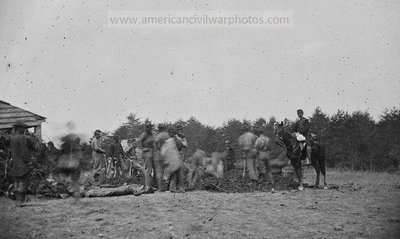
Battles of the Civil War
May 31-June 12: Lee thoroughly understood Grant's strategy that not only targeted Richmond, but also the James River where Grant could circle the nearby capital of Virginia. When Grant reached Cold Harbor, his forces were only 15 miles from Richmond. The Union attacks were a series of self carnage. The Confederate cannon and musket fire was deadly. In the Illustrated History of the Civil War, Geoffrey C. Ward, quotes an unnamed rebel general as the bloody attacks continued that it was not war but murder. The Union had suffered 50,000 casualties in one month. Mary Lincoln called Grant "a butcher".
Grant internalized his suffering; disengaged from the enemy and relentlessly pushed southward.
June 15: It was no surprise to Lee when Grant cut around Richmond and crossed the James River. Union engineers built a pontoon bridge that moved the army over the river in a four day period. However, Lee expected a quick turn north toward Richmond and reinforced troops to protect the city. However, surprisingly to Lee, who had up to this point anticipated Grant's strategies, the Union forces did not turn north to Richmond. The Union army continued its drive westerly to begin a siege of lightly defended Petersburg.
When the Union vanguard reached the City of Petersburg, its forces outnumbered the rebels by five to one. However, it took all day for the Union to gain ground, and when darkness fell the attack was suspended. The Confederates were reinforced and both sides dug in for a siege that none anticipated would last ten months.
Much has been written about the attempt to undermine the defensive fortifications at the end of July. This tactic had been practiced for centuries. Experienced miners dug a tunnel and filled it with gun powder intending that it would blow the defensive walls. Unfortunately, it exploded killing all those Union soldiers in and near the shaft. They were not deterred. An attack was mounted, but the Union troops foolishly crossed the ground by traversing through the now open tunnel. They were exposed to enemy fire from above, and at least 1,000 were forced to surrender. General Burnside was unceremoniously relieved.
The Overland Campaign strategized by Grant was coming to a halt. Union forces fighting in the Shenandoah Valley (Virginia) added another defeat for the north. The army that Grant's plan intended to aid in the attack on Richmond, arriving from east of the city, and up the James River, was completely stalled down river. It was not until August 18 that Union forces gained control of the Petersburg rail lines after a three day fight at Globe Tavern. This ultimately spelled doomed for the confederate defenders. Yet, the fighting continued.
Some historians surmise that Lee's strategy was to create delays and build up northern casualties that would affect the forthcoming presidential election and create dissatisfaction with Lincoln. A new face in the White House, swayed by popular opinion, would readily seek peace with the Confederacy. Lincoln's opponent was none other than the former General George McClellan running on a peace platform. This campaign rhetoric preaching peace was contrary to his stated belief in the preservation of the Union and the defeat of the rebels.
July and August were a mixed bag of small battles and skirmishes without consequence on the course of the war waged in Mississippi and Virginia. One exception was the progress of General William Tecumseh Sherman in his drive toward Atlanta, Georgia.
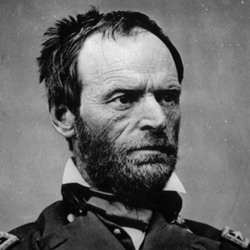
General Sherman fought war without regard to civilian casualties. This was a departure from the civilities expected and practiced in the conduct of war in the 19th century. Sherman understood the relationship between the soldiers and the civilians at home. He destroyed and burned what he could not confiscate. Lower morale on the home front would negatively affect those on the battlefield. In return, he and his men were hated by Southern women.
June 27: Sherman started his troops on an easterly trajectory in early May. He commanded about 100,000 men divided between the Army of the Cumberland, Army of the Tennessee and Army of the Ohio to face the enemy's Army of Tennessee commanded by Gen. Joseph Johnston, a victorious veteran of many prior campaigns.
Lee had ordered General Johnston to impede Sherman's progress. There were a series of skirmishes that were generally favorable to the Union particularly because Johnston was evading pitched battle. Then they faced each other at Kennesaw Mountain, Georgia--about 20 miles from Atlanta. Sherman had double the troop strength of Johnston and was anxious to seize the advantage. He ordered a frontal assault against the entrenched defenses---and paid the price. He was anxious to destroy the enemy army, and had impetuously ordered a frontal attack and was repulsed.
Johnston was rewarded for his victory by President Davis. The Confederate president discharged the general summarily less than a month later. He had disliked this general over a period of years and was unhappy with his officer's supposed penchant for retreating in the face of superior forces. In February 1865, Johnston returned to duty at the personal request of General Lee.
July 20: John Bell Hood was the newly promoted commander of the Army of Tennessee. He knew his predecessor's fate and ordered an attack based on Johnston's plan as columns of the Army of the Cumberland crossed Peach Tree Creek.
Sherman had divided his three armies on his march potentially exposing each. The plan's strategy was excellent, but its execution was faulty. The Federal lines held after some initial setbacks and the rebel army suffered greater losses. In contrast to some of the extensive losses in prior battles, casualties were relatively light.
July 22: Sherman next brought his forces against Hood's lines just outside of Atlanta. He ordered the shelling of the city. The battle raged outside the city with minimal consequences, but Confederate casualties over 5,000 were a serious blow to Hood.
A new battle was forming east of the city on Bald Hill held by the Union troops against rebel attack. To the north of the city, Confederate forces were having some success until Union artillery forced a rebel retreat. Atlanta still held.
Several weeks of similar fighting ensued when the opposing forces met in a final test about 12 miles south of Atlanta.
Battles of the Civil War
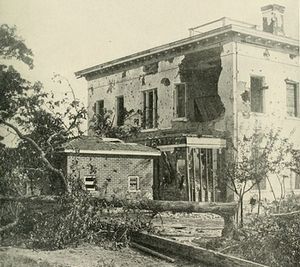
Battles of the Civil War
Mobile Bay
Joint attack by Navy and Army
Western Theater
August 5:Mobile Bay, Alabama was the site of a joint U.S. Navy and Union Army coordinated attack on one of the few coastal harbors heavily defended by the confederacy. The Confederates stationed a small naval force including the iron clad Tennessee protected by the heavy guns of three coastal forts. Rear Admiral Farragut led the United States ships through heavily mined waters to contest the smaller rebel navy. They came under attack from the forts which diverted Union fire from the Confederate ships. Finally,after the Tennessee was sunk, the forts surrendered to Union forces on shore. However, no attempt was made to attack Mobile.
Historically, The Farragut shout out during the battle, "Damn the torpedoes, and full speed ahead" is largely apocryphal. This does not disparage Farragut's courage who ordered his flotilla through mine filled waters in Mobile Bay and under the guns of the on-shore forts.
Atlanta Campaign ---continues
August 31-September 2: On August 25, Sherman concluded that his focus should be on cutting Confederate supply lines and deprive Atlanta's defenders and citizens. He chose to move against railroad lines at Jonesboro and drew Hood and his army from Atlanta. Hood underestimated the strength of Sherman's support units and on September 1 suffered heavy casualties while northern forces were destroying the rail lines.
Hood retreated in good order to Atlanta, but decided to abandon the city on September 1. On September 2, Sherman entered Atlanta. He kept his army there for two months and then ordered the evacuation of the city.Then he burned down the city and continued his march onto Savannah and the sea.
The capture of Atlanta cemented a second term victory for President Lincoln in the forthcoming election.The north finally could celebrate a clear cut victory in the battle to subdue the south.
Battles of the Civil War
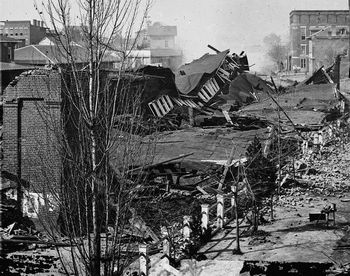
http://www.learnnc.org/lp/media/
September 19: Confederate General Jubal Early was a thorn in the side of the Union forces. His string of victories was impressive. In 1864, he was sparring with General Philip Sheridan's Army of the Shenandoah in that Virginia valley for months. Each were waiting for an opportunity to engage in a definitive battle. The opportunity arose when Sheridan's intelligence learned that Early's Army of the Valley had dispersed its forces over a 24 mile area. Early's reinforcements arrived immediately prior to the day's battle to cover the deficit.
The battlefield at Winchester, Virginia had seen similar action in the prior two years (May 25, 1862, June 13-15, 1863). This battle was replete with attack and counter attack with both frontal and flanking actions. Late in the day, Sheridan ordered a coordinated assault on all fronts. The results hung in the balance until Sheridan's cavalry units swung into action and over powered rebel units on their left flank. Sheridan's infantry took advantage of the situation and added its weight to the attack and completed the break in the enemy lines.
Early was forced to withdraw from Winchester with the Union in hot pursuit. Sheridan was ecstatic and lavishly praised his army. General Jubal Early had no intention of folding in the face of the Union victory. The Confederates were still in the game. The siege of Petersburg continued. President Jefferson Davis responded to set backs:
"There is no military success of the enemy which can accomplish its (Confederate States) destruction" .
October 19: It has been suggested that politics may have been in play in the time between the Winchester battle and Sheridan's tactics taken from the pages of General Sherman's scorched earth policy. More Union generals were directing attention to destroying crops that supported the Confederate army as well as burning other potential assets relied upon by the South.
The south's attention was to create a disastrous defeat to deflect pro Lincoln votes in the November presidential race. General Jubal Early had no compunction about using his army to undermine Lincoln politically.
Early massed his forces to destroy the Sheridan army at their encampent at Cedar Creek, a scant 17 miles from his (Early) earlier defeat at Winschester. At 5 A.M. he commenced an attack on the unsuspecting Union troops who soon were forced into a disorderly retreat erasing a 10,000 Union troop and cannon advantage. They began to fall back when the retreating blue uniforms merged with the lines of another Union corps. Their retreat was protected by a brigade that had slowed Confederate advances. Early had captured the camps of several divisions and, in a perverse chain of events, that spelled doom for his army.
General Sheridan had passed the night at Winchester away from his camps. As more reports of heavy fighting filtered into his headquarters, he mounted his horse and reached the battle field by mid morning to find his troops in a disorganized state. He rode before his men and rallied them with these stirring words:
"Come on back, boys! Give 'em hell, God damn 'em! We'll make coffee out of Cedar Creek tonight".
New lines formed and Sheridan's men prepared a strong defensive position. They had a brief respite from further attack as the shortages deprived rebels scoured and looted the abandoned Union camps. The halt in action seemed to take the steam out of Early's aggressive tactics.
By late afternoon, Sheridan swung his men into an all out attack coordinating his infantry with cavalry led by Lt.Col. George Custer. The Confederate Army was now desperate to retreat and fearful that they might be cut off from crossing Cedar Creek. They dumped their booty and cannon to make good their escape.
The Shenandoah now belonged to the Union army. It would no longer serve as a conduit for Lee's incursions into the north and a threat to Washington, D.C.
Battles of the Civil War
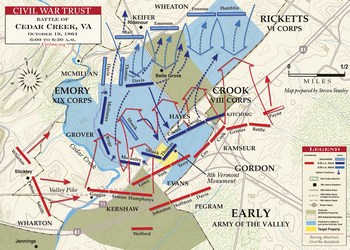
Battles of the Civil War
Battle of Westport,
"Gettysburg of the West"
October 23: Westport (Kansas City) Missouri was a transit point into the western frontier. It was also in a state that the south wished to preserve for the Confederacy. It would serve as the setting for the confrontation of The Union Army of the Border against General Sterling Price's Army of Missouri. The Confederates were at a serious disadvantage with its smaller manpower and, until this match- up, had been confined to actions involving small raids. This was about to change.
The Union army led by General Samuel Curtis was an amalgam of regular forces and volunteer Kansas militia. This led to a dispute between brigade commanders of equal rank regarding subordination of command. This disruption was the background of a series of thrusts and parries between the Curtis and Price commands with the latter holding earlier advantages.
Prior to noon of October 23, Price ordered his forces to attack. This required crossing open prairie and over and through a wooded creek. By 12 o'clock, Price was fighting both to his front and rear. Thirty cannons were firing on his forces that fought back with one cannon. Ultimately, Price would leave the field pursued by northern forces. Missouri was Union territory until the end of the war. Its significance earned the sobriquet "Gettysburg of the West". However,the 3,000 combined casualties hardly met the standards of the original.
History records the names of participating Union soldiers synonymous with western lore: Private Buffalo Bill Cody, Scout, Wild Bill Hickock, militia volunteer, Mountain Man, Jeremiah Johnson.
Battle of Franklin
Army of Ohio vs Army of Tennessee
Nashville
November 30: General John Bell Hood, subsequent to his defeat at Atlanta, had the option to confront Sherman again during his eastward march or move north into Tennessee. That state had been a closed book for almost a year. Hood moved into Tennessee.
Hood was opposed by Maj.General John Schofield who hurriedly erected defenses outside Franklin. Hood began the day with initial successes against the lightly erected defensive outer works. Hood may have overplayed his hand when he ordered a series of direct charges that were largely repulsed. His losses were horrendously high---over 6,000 casualties against Union losses of about 2,000.
December 15-16: Although the Union army strategically retired from Franklin to the stronger defenses at Nashville, theirs was a notable victory. Two weeks after Hood was bloodied at Franklin he followed Schofield to Nashville. He erected barriers outside of Nashville hoping that the Union commander, General George Thomas would attack. Thomas obliged, but his feints, masking the true nature of the attack, crushed Hood's forces. The effectiveness of this Confederate force destroyed. In two weeks, Hood had lost 14 generals and an army.
Battles of the Civil War
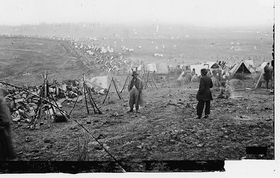
Battles of the Civil War Union Lines at Nashville
Library of Congress
1865
Battle of Fort Fisher II
Army and Navy Joint Operation
Wilmington, North Carolina
January 13-15: Subsequent to the Union's unsuccessful first attack on Fort Fisher in the closing week of December 1864 , the Union general, Benjamin Butler was relieved and replaced by Maj.Gen.Alfred Terry of the "Provincial Corps". This force included a division of Black soldiers who were intimately involved in the action.
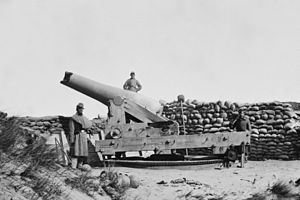
Damaged Confederate Gun December 23, 1864
On the 13th, the navy commenced a heavy bombardment on the fort. On the 15th of January, a combination of amphibious landing and an infantry attack was thrown against the rear of the fort. The former was repulsed, but the intensity of the latter attack forced General Braxton Bragg to surrender the fort.
Inevitably, the port city, Wilmington, guarded by Fort Fisher, 30 miles down river, was then fair game for a Union siege which was immediately commenced by Maj. Gen, John Schofield's 12,000 troops. Wilmington was defended by 6,000 confederates who were sealed off from any aid. On February 22, they finally succumbed to an attack and surrendered the city. The Confederacy lost its southern outlet to the sea.
Battles of the Civil War
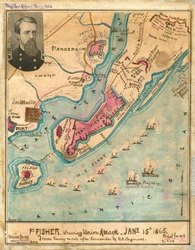
Battles of the Civil War
Battle of Rivers Bridge, South Carolina
February 3: General Sherman had burned and twisted railroad track on his March through Georgia to reach the Atlantic seacoast. With no serious opposition, by mid January he turned his forces northward to the Carolinas.His army reached the bridge over the Salkehatchie River where Sherman met resistance. After relatively light casualties,the rebels retreated after a brigade of Federals waded through a swamp placing them in an advantageous, offensive position.
Battles of the Civil War
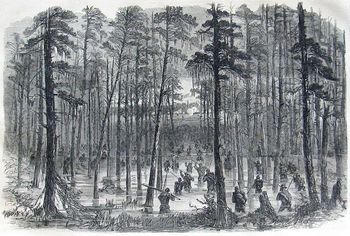
Battles of the Civil War
Theodore Davis Harper's Weekly April 8, 1865
Columbia, South Carolina
February 17 : Sherman now effectively controlled central South Carolina. His forces shelled Columbia, and under General Henry Slocum occupied, looted and probably burned half of the city. It has been reported that Union forces were gleeful in destroying property in South Carolina as the source of secession and first strike against the Union at Fort Sumter.
March 19-21: This closing battle in North Carolina was General Johnston's swan song. His undermanned forces, the Army of Tennessee, (3 to 1) attacked Sherman's forces. His first attack dislodged two Union divisions that were quickly replaced in the line. Five attacks were repulsed. Union counter attacks forced Johnston to Mill Creek who withstood initial attacks by Maj. Gen. Joseph Mower who was anxious to continue. General Sherman, however, restricted further attack which admittedly was a serious tactical mistake. Johnston withdrew under the cover of darkness.
Battles of the Civil War
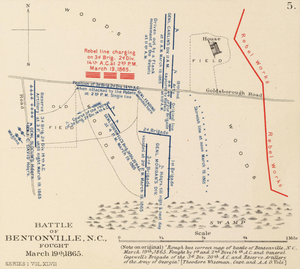
Signals war will end in Virginia
April 1: The siege of Petersburg was in its ninth month. General Grant recognized the Lee strategy which required joining his Petersburg forces with General Johnston in North Carolina. Southwest of Petersburg, General George E. Pickett, survivor of Gettysburg's "Pickett's Charge", was battling Philip Sheridan's forces for control of a road that was Petersburg's last supply route and control of the Southside Railroad.
Sheridan's heavy assault against the Confederates defensive lines cracked it. At the time, Pickett had been away at an officer's picnic and returned in time to join his army's retreat. The railroad was lost.
Battles of the Civil War
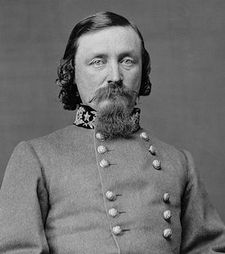 |
Battles of the Civil War
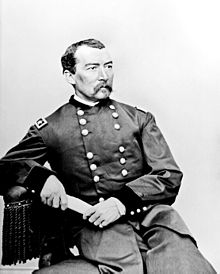 |
April 1-2: While the battle at Five Forks waged west of Petersburg, the Union forces were engaging the enemy who were dug in at various points about the city. Several entrenchments were gained by the Federals, but counterattacks were threatening the hard won positions. The union troops held their positions. Each of the five forts and lines about the city began to fall to Grant's attacks.
Longstreet was rushing reinforcements from Richmond, but the efforts merely bought time for Lee to abandon Petersburg with a severely depleted army. The loss of Petersburg meant the loss of Richmond. More significantly, it meant the end of the rebellion.
Battles of the Civil War
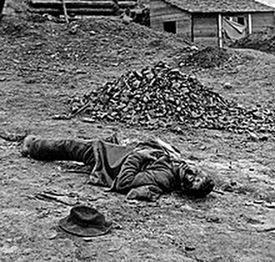
April 5: Sheridan was in a race to cut off Lee's exhausted and fatigued men to block his intended route to connect with Johnston. The Union army reached the vicinity of Amelia Court House and cut another rebel supply line.
April 6: Sayler's Creek. This battle was an extension of Lee's extrication from Amelia Court House. The Confederates who had marched from Amelia Court House were hard pressed to fight. Their lines were overrun and suffered heavy casualties. Six Confederate generals surrendered.
April 6-7: General James Longstreet, next in command under General Lee, attempted a blocking action to protect the Confederate retreat by burning a bridge over Appomattox Creek. Union forces foreclosed the attempt.
April 6-7: Grant clashed with Lee at Cumberland Church. He knew Lee's plight and asked him to surrender. Lee's message, under a flag of truce, was that he was not in dire straights and entitled to terms. However, Sheridan had blocked his last escape refuge in Lynchburg.
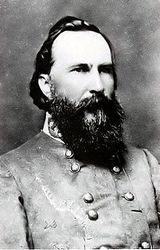
General Longstreet
April 9: Longstreet's forces were heroically resisting the
attacks of the Federal troops. The sight of Union reinforcements sealed
the day, and he was forced to send an appeal to Lee for more men.
Lee was bereft:
"There is nothing left for me but to go and see General Grant, and I had rather die a thousand deaths"
And so Lee met Grant at the Appomattox Court House. It had been 20 years since they last spoke. Each sat at separate tables while Lee signed the surrender terms.
|
|
|
Timothy O'Sullivan |
Hal Jespersen |
Battles of the Civil War
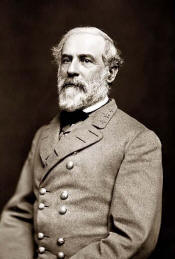
Commander in Chief Surrenders
General Lee to his troops:
"After four years of arduous service, marked by unsurpassed courage and fortitude, The Army of Northern Virginia has been compelled to yield to overwhelming numbers and resources.-----".
April 14: President Abraham Lincoln was assassinated at Ford's Theater. One of the last "soldiers" to die for the preservation of the Union.
Smithsonian.com: "The night of the assassination, Lincoln's bodyguard snuck (sic) off to drink in the same saloon as John Wilkes Booth".
Battles of the Civil War
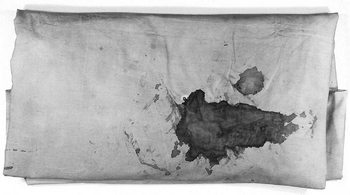 |
JAIC online Derringer, the murder weapon 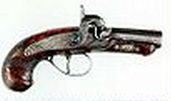 |
Continue to Civil War Facts (Chapter 3, Battles of the Civil War)
American Wars | What Caused the Civil War | Battles of the Civil War
